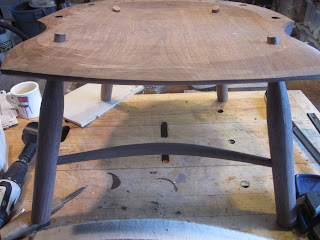The basic idea is simple, each shape should have a geometric logic within itself and a sense of tension with the other pieces that it joins to. Without this, parts and entire pieces of furniture look "ooey gooey", like they are melting or have worn slack.
I have a few techniques that I use to help create the logic within a piece. Mostly, they involve following a series of geometric shapes as inbetween steps so that the final shape has a hidden framework that helps define it.

I was thinking about this today while shaping the curved stretchers for a rocker that I am finishing. I had some issues when bending the stretchers turned to their final shape, the tapers had too much runout and cracked. So I turned the piece at a cylinder and bent it. The bend went fine, but then it was up to me to carve the tapers.
As you can see, I shaved the round part into an octagon. Round is a time consuming and difficult shape to adjust and fair. When I have to remove a bunch of wood, I usually revert to the octagon, which makes it very simple. I just keep working on each facet until the taper of the facet is pleasing and matches the other 7. Then round is an easy step away. Note the felt on the bending form. It took a negative impression of the stretcher and left the surface of the walnut round and uncompressed.
Here is another shot of the stretcher, and yes, I can finally work outside.
Here is is inside the chair. I like the way that the stretcher "pushes" against the legs and echoes the curves of the rockers. The only issue is my every worsening reaction to the walnut, which might make this my last project with this great wood. But of course, never say never.




5 comments:
Pete thanks for the great post. As for your reaction to the walnut, I would like to share with you and your readers something that allowed me to continue woodworking.
I had a NASTY reaction to redwood and seemed to be sensitized, to some degree, to most other wood dust. I saw a video that Mark Spagnuolo did on respirators and shop safety, that saved my working with wood.
http://www.thewoodwhisperer.com/videos/dust-in-time/
I have been using the 3M 7500 series respirator with the 3M 2097 filters and have not had a reaction since.
http://solutions.3m.com/wps/portal/3M/en_US/3M-PPE-Safety-Solutions/Personal-Protective-Equipment/Products/Product-Catalog/?N=5548558&rt=c3
http://www.amazon.com/3M-Particulate-Filter-Organic-Relief/dp/B00328IAO0
Please check it out! I would hate to hear that you would have to give up working with this beautiful material.
"Oh ya" What a beautiful thing.
Ray,
thanks for the tips. I will continue to seek out ways to work healthy, but I must say, I got into chairmaking to get away from earmuffs and respirators! Thanks again,
Pete
Pete, I too enjoy working without respirators and that is one of the reasons I enjoy building chairs. I hope you are able to continue to work with walnut, you do it so well!
Peter, thanks for your ideas in overcoming moisture content in bending - been experimenting with Australian silky oak - to date - failures - I will implement your ideas of a water reservoir - being an Engineer I can see merit in your idea - Richard Crandon
Post a Comment